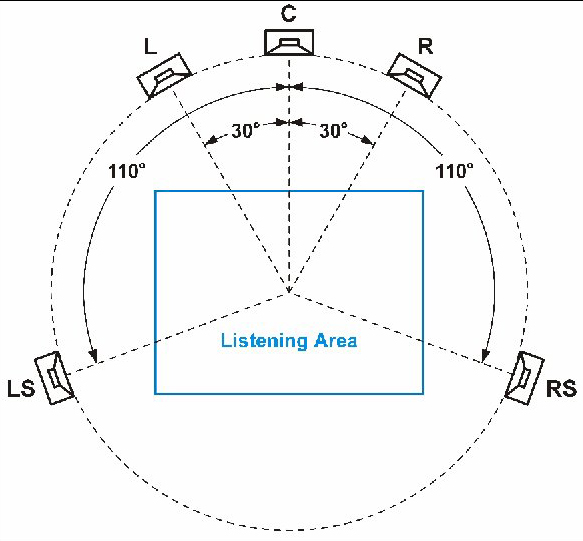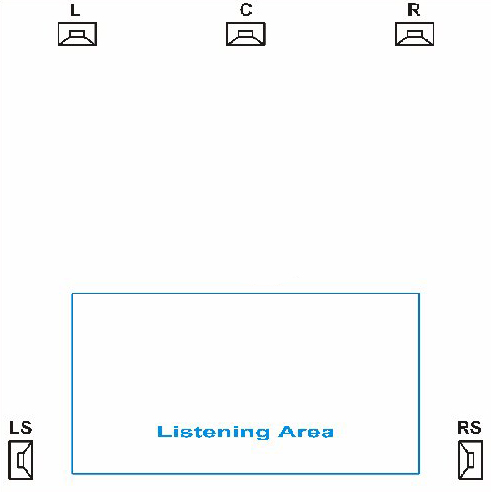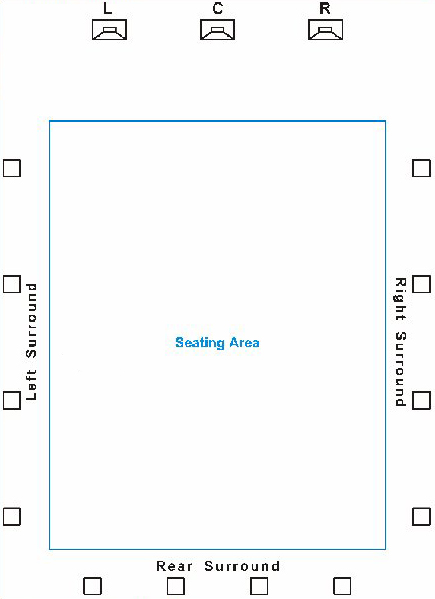
When a wide, full sound stage is needed, pair-wise panning can produce effective localization if enough loudspeakers are used to minimize the angle between them.
Computer-controlled routing and panning systems are available and especially useful for complex layouts with many loudspeakers.
Panning works well if the loudspeaker layout is optimized and the audience area is not too wide for it.
For electronic sources, it’s usually the simplest available method for creating a wide, spatially interesting sound.
Therefore it’s useful for a system layout to accommodate both panned sources and individual discrete sources. Because most audio recordings are made with pair-wise panning, the usual recommendation for a home audio system accommodates this type of program source.
For good performance, adjacent loudspeaker channels subtend a small angle (less than 45 degrees) from the listener’s vantage point, and are in close time alignment with each other.
Central Listening Area
The ITU-R recommended loudspeaker layout for 5.1 systems, shown in Figure 1, is time-aligned and optimized for music, but it has a small central listening area.
And while the two rear loudspeakers can work nicely as discrete sources, surround panning will not work well because the angle between these loudspeakers is too large.
For group listening and viewing, Dolby recommends the layout shown in Figure 2. The surround loudspeakers are to be 3 feet above the listeners, and the linear LCR layout increases the size of the listening area.
This arrangement allows for an increased listening area with a small tradeoff in time alignment, and the use of a diffused surround field.
Expanding this to a larger room yields the typical commercial cinema arrangement shown in Figure 3.
Note that additional surround loudspeakers provide more even sound distribution, satisfying the goal of envelopment, and allowing audible but imprecise effect panning in the surrounds. A versatile, high-performance surround system for music will require more loudspeaker channels for the sides and rear.
A left-center-right rear array makes a significant improvement, and if the budget and space permits, side channels could feasibly complete a horizontal-plane surround system.
The use of eight channels with 45 degrees between adjacent channels yields good performance with program sources incorporating pair-wise panning.
Since we can’t change the velocity of sound in air, the only way to eliminate excess differential delay problems in a large venue is to keep the loudspeakers near enough to the listeners.
Having significant overall propagation delay to the furthest seats from the stage is usually not a problem. People are accustomed to that, as long as the sound seems to originate at the stage.
Therefore a large system that provides good surround sound, in addition to good stereo stage sound, can be made with a combination of a multichannel front array and a distributed loudspeaker system with coverage across the audience.
A left/center/right main stereo system above the stage is a good start, and a variety of well-documented ancillary techniques can be used to enhance its performance.
These include utilizing multiple additional loudspeakers as delayed fills to enhance coverage of the rear portion of the audience.



